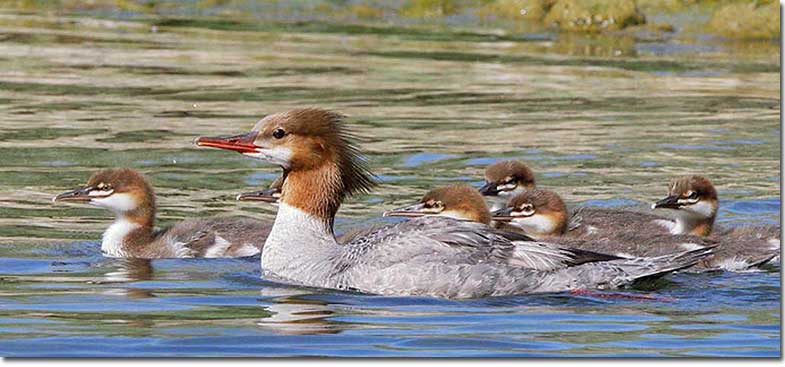
Ducks are beautiful aquatic birds. They are also fun and easy to watch!
North America has blessed us with lots of duck-watching opportunities, and California is no different. With its marshes, lakes, and coastal waters, California is a true duck haven!
Most Common Duck Species in California
Based on eBird data, our list shows 15 most common ducks in California.
We arranged these ducks from most common to least common, and included information about their behavior and habitats. To help identify these handsome birds, we also mention key field marks!
Mallard
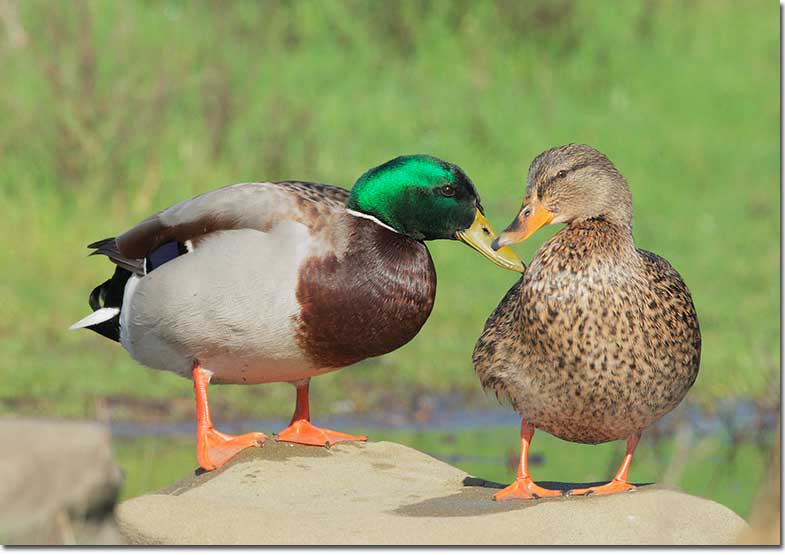
Scientific name: Anas platyrhynchos
Length: 23 inches
Wingspan: 35 inches
Mallards are the most familiar duck species. For lots of folks, this is “the duck”. They have been domesticated for centuries and lots of them are fed at urban ponds and lakes.
However, make no doubt about it, Mallards are wild birds that also live in lots of wild and remote areas in most of North America. The males have a dark green head, narrow white collar, yellowish beak, and dark brown chest.
Female Mallards, though, can be trickier to identify. They are brown with some paler brown and dark markings, and have a gray-brown neck and head with a dark cap, and a dark line through their eyes.
In flight, we can also recognize female Mallards by their pale tail, and two white wing bards bordering a green-blue wing patch.
In addition to eating bird food and vegetables, Mallards dabble in shallow water for plant matter and small creatures.
Key identifications:
- Big duck with a glossy green head and yellowish beak.
- The female has a dark center mark on her orange beak.
- Short, pale, or white tail.
Ruddy Duck
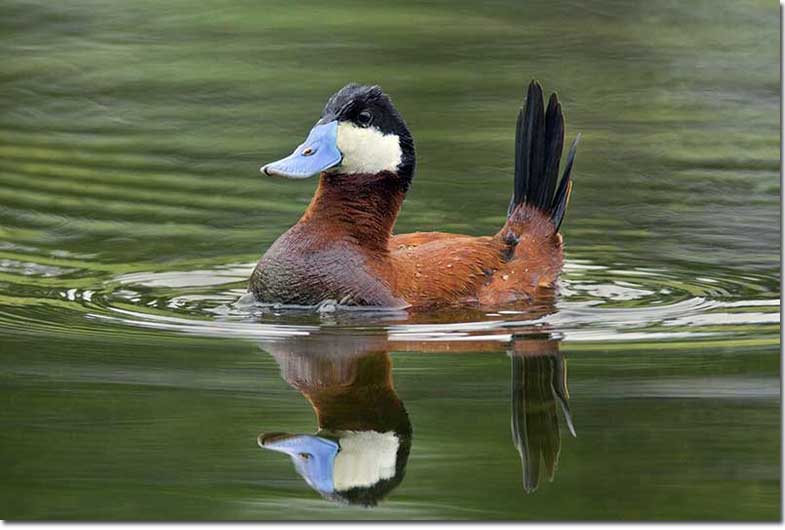
Scientific name: Oxyura jamaicensis
Length: 15 inches
Wingspan: 18.5 inches
Ruddy Ducks are small diving ducks with a unique, big-headed look, and a stiff tail that they often hold upright. Breeding males are a beautiful chestnut bird with a black cap, and a white throat and cheeks. They also have a big and pretty, blue beak that contrasts with the other colors on their head.
Female Ruddy Ducks are grayish birds with darker, more uniform upperparts, and a thick black line on their pale face. They have a duller, darker, more grayish beak than the male. In flight, Ruddy Ducks have mostly dark, rather short and narrow wings.
Ruddy Ducks dive underwater to forage for small aquatic creatures.
This small duck species breeds in shallow marshes and lakes, but is more numerous during winter months. However, you can still see them throughout the year in California!
Key identifications:
- Small duck with big bluish beak and a dark cap.
- White cheeks or a dark line on pale cheeks.
- Longish, stiff tail often held upright.
Bufflehead
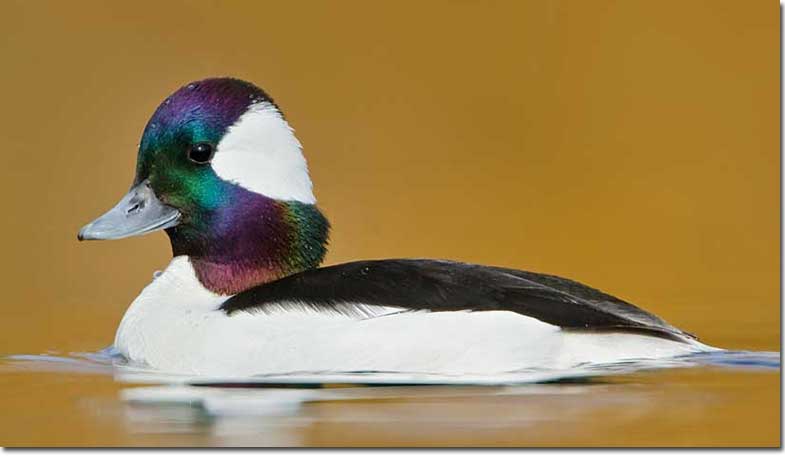
Scientific name: Bucephala albeola
Length: 13.5 inches
Wingspan: 21 inches
Buffleheads are small, cute ducks with rounded heads and stout little beaks. Males are bold, black and white birds with a big white patch on their head. In good light, their head also has green and purple iridescence.
Female Buffleheads are more gray-brown with a white belly, and have a smaller white head patch.
During their fast flight, Buffleheads show a white patch in their wings although the female’s white patch is smaller. These ducks breed on northern, forested lakes in Alaska, Canada, and parts of the northwestern USA. Some birds stay to breed, but you can mostly see them from fall to spring.
Key identifications:
- Small chunky duck with stout gray beak.
- Rounded head with a bold white patch.
- Mostly black and white or grayish with a white belly and small white wing patch.
Northern Shoveler
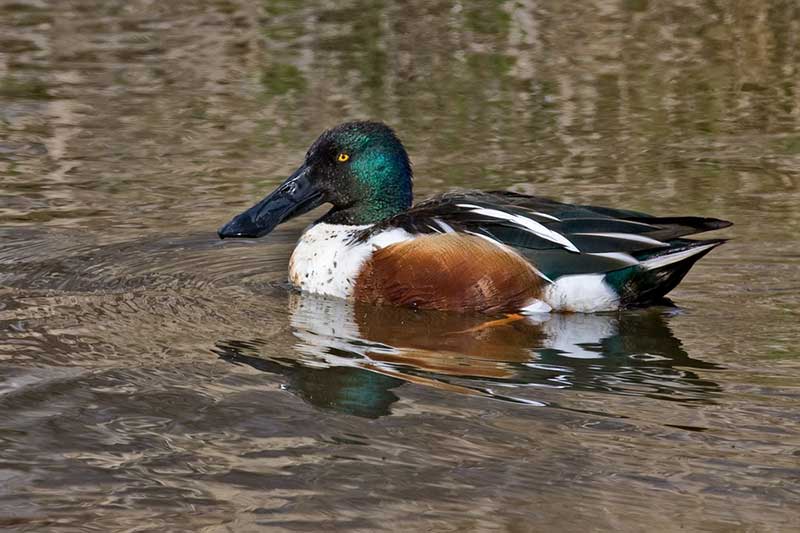
Scientific name: Spatula clypeata
Length: 19 inches
Wingspan: 30 inches
Northern Shovelers are a distinctive duck species with a big, prominent beak. Males have striking plumage with a dark green head, and white and chestnut underparts. They are also white and gray on their back, have orange legs, and show blue shoulders in flight.
Female Northern Shovelers are tawny-brown ducks with lots of buff markings, and an orange and gray beak. Both sexes also have a pale tail.
These pretty ducks like to float in marshes and other shallow wetland habitats.
Key identifications:
- Over-sized, flat beak.
- Male has a white breast, red-brown sides and belly, and dark green head.
- Female has a pale tail and orange and gray beak.
American Wigeon
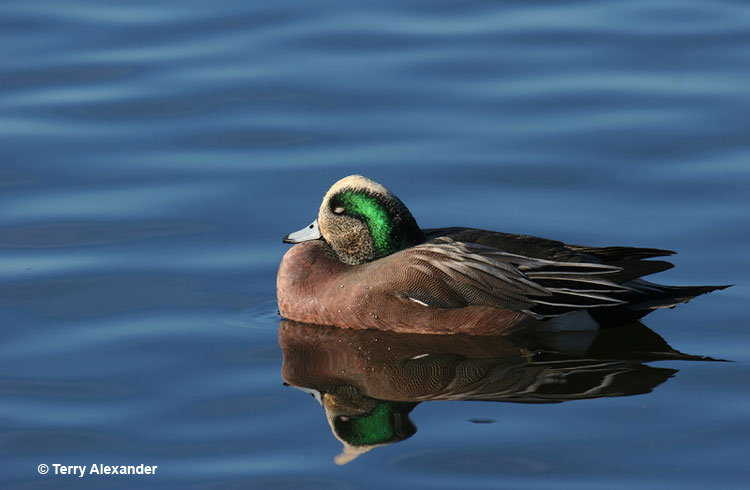
Scientific name: Mareca americana
Length: 20 inches
Wingspan: 32 inches
American Wigeons are medium-sized ducks with a smallish gray beak. Males are gray with a white crown, some dark green near their eyes, and peach-brown colors on their chest and sides.
They also have a black undertail and show white shoulders in flights. Females look like males but lack white and green on their heads and are a bit duller in general. Both sexes have pointed tails and a white belly especially visible in flight.
American Wigeons like to graze grass and eat grain while walking at the edge of wetlands and in wet fields. They can also pick plant matter and small creatures from the surface of the water and even steal food from other ducks!
This waterfowl species breeds in cold, shallow marshes in northern areas, but some stay in California. As with other winterers, you’re better off seeing them during the non-breeding season.
Key identifications:
- Rather small pale gray beak.
- Peach or gray-orange chest and flanks.
- Male has a white crown and white shoulders, female has grayish head with a dark area around her eyes.
Gadwall
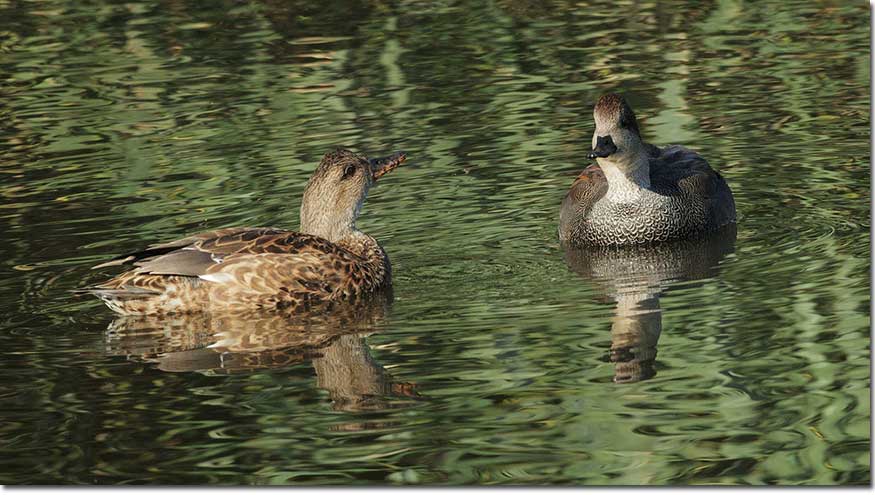
Scientific name: Mareca strepera
Length: 20 inches
Wingspan: 33 inches
Gadwalls are medium-sized ducks with a small white patch on the base of each wing. Males are gray ducks with a paler grayish head, some brown feathers on their wings, and a black rump, tail, and undertail.
Female Gadwalls look a lot like female Mallards and have gray-brown plumage with buff markings, and a paler grayish head. Like hen Mallards, they also have an orange and black beak but it is mostly gray on the upper part of the bill.
In flight, both sexes show white bellies, the small white mark on their wing, and much white on their underwings.
Gadwalls forage for seeds and other plant matter in and near shallow water.
Key identifications:
- Male is mostly gray with black rear end.
- Female has grayish head and gray and orange beak.
- Small white patch on base of wing.
Cinnamon Teal
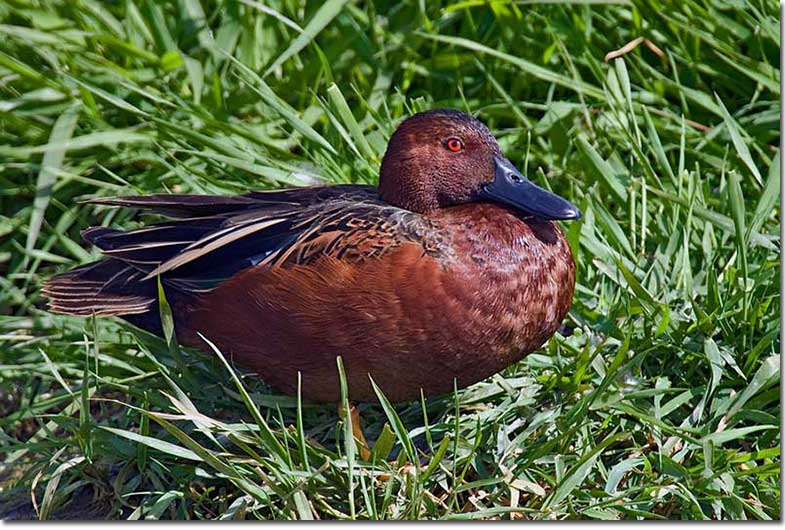
Scientific name: Spatula cyanoptera
Length: 16 inches
Wingspan: 22 inches
Cinnamon Teals are small ducks with reddish eyes and a fairly large, dark beak. Breeding males are one of the most handsome ducks in North America. When competing with species like the Hooded Merganser, Redhead, and Northern Shoveler, that’s saying something. However, I stand by my word!
Male Cinnamon Teals are a beautiful, reddish-chestnut highlighted by caramel-colored plumes on their back. They also have a black rump and undertail, and show pale blue shoulders in flight.
Females and non-breeding males are duller, brown birds with mottled buff markings. They also have a plain pale brown face that lacks a dark line through their eye but still show a pale blue shoulder in flight.
Cinnamon Teals dabble for plant matter and small creatures in shallow marshes and at the edges of shallow lakes.
Key identifications:
- Rich, red-brown plumage.
- Female has a reddish eye and a plain face.
- Blue or blue-gray shoulders on its wings.
Surf Scoter
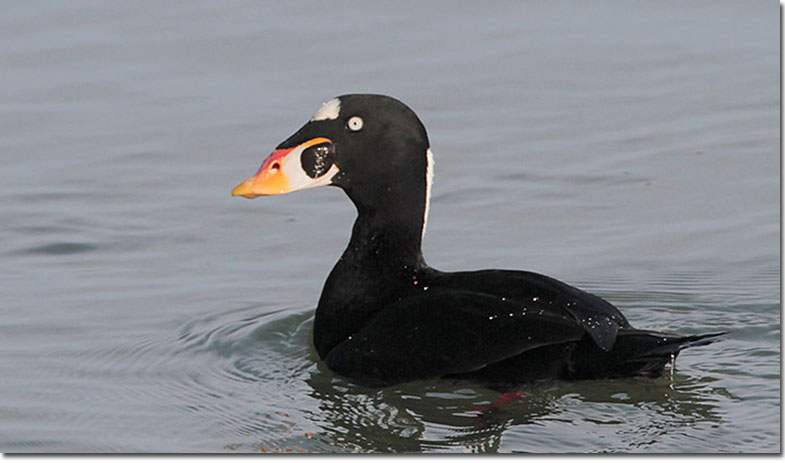
Scientific name: Melanitta perspicillata
Length: 20 inches
Wingspan: 30 inches
Surf Scoters are hefty, jet-black ducks with a big swollen beaks, especially the males. Their large beaks are white, orange, and red, and have a big round black spot!
The male’s other main field marks are a small white patch on the front part of the crown and a big white patch on the back of the neck.
Both sexes of the Surf Scoter also have staring white eyes! However, female Surf Scoters aren’t as fancy. They are dark gray-brown, have a dark cap, and some pale marks on their head.
Young birds have more pronounced white patches on their head, and an extensive whitish belly.
You can spot these Californian ducks throughout the year.
Key identifications:
- A beak with a swollen appearance.
- Dark wings in flight.
- White line at the base of the bill.
Northern Pintail
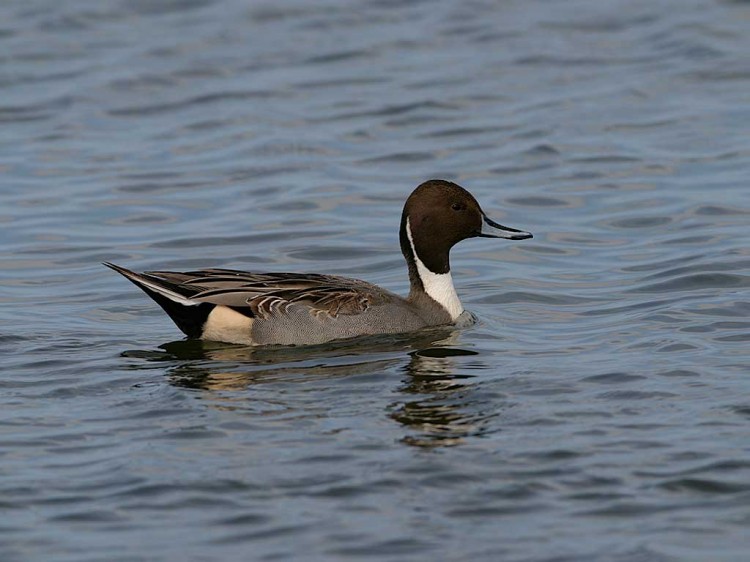
Photograph © Sam Crowe.
Scientific name: Anas acuta
Length: 21 inches
Wingspan: 34 inches
Northern Pintails are fairly large and slender, gray and creamy white ducks with long necks, and long tails. Breeding males are handsome birds with dark, chocolate-brown on their head and neck, a black undertail, and a long pointed tail feather.
Females and nonbreeding males are gray and tawny birds with a plain, pale tawny head and neck, and a gray beak. In flight, Northern Pintails also show long, pale gray wings, and the males have a dark green patch on the base of each wing.
We see these neat ducks in shallow marshes, and on lakes and other wetlands. They often form small groups that can flock with other waterfowl species.
They forage for grains and small aquatic creatures by dabbling in very shallow water and picking food from the wet ground while walking at the edge of the water, and in wet fields.
We see these pretty ducks in shallow wetland habitats in most of North America and California is no exception.
Key identifications:
- Fairly large duck with a long, slender neck.
- Pointed tail.
- Dark brown or tawny head and a gray beak.
Ring-necked Duck
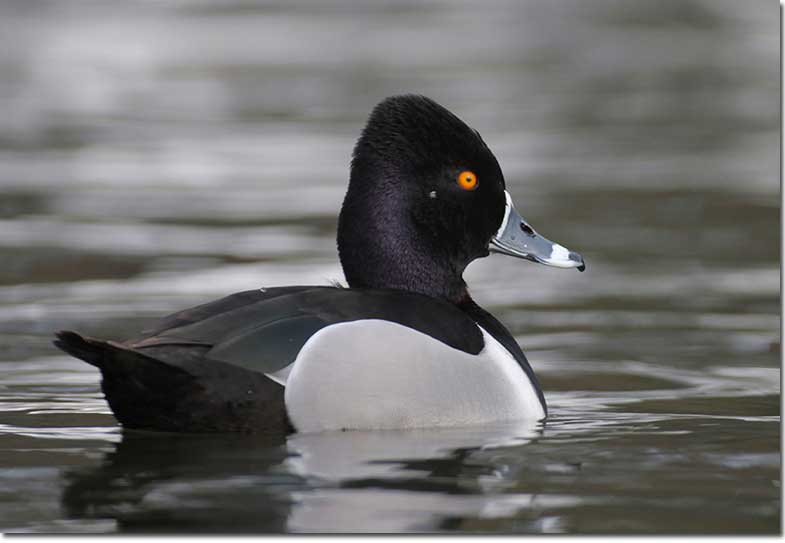
Scientific name: Aythya collaris
Length: 17 inches
Wingspan: 25 inches
Ring-necked Ducks are one of those birds that don’t have the best of names. While males do have a brown ring on their necks, it blends in with their black neck and can be really hard to see.
Ring-necked Ducks should really be called, “Ring-billed Ducks”! The males are best recognized by the white ring near the black tip of their dark gray beak, and their combination of a black back, head, neck, and chest. They also have gray sides and a white mark near their black chest.
Female Ring-necked Ducks are plain, brownish birds with pale bellies and narrow white spectacles on a grayish face. They also show a bit of white on their face, near the base of their bill.
Ring-necked Ducks dabble and make shallow dives for a variety of food items. They like to eat plant matter, insects, and other small aquatic creatures. We find them in a variety of shallow wetlands, but in California, mostly from fall to spring.
Key identifications:
- Male has black back, head, and chest.
- Gray sides with white near the black chest.
- Female has narrow white spectacles on gray face.
Common Merganser
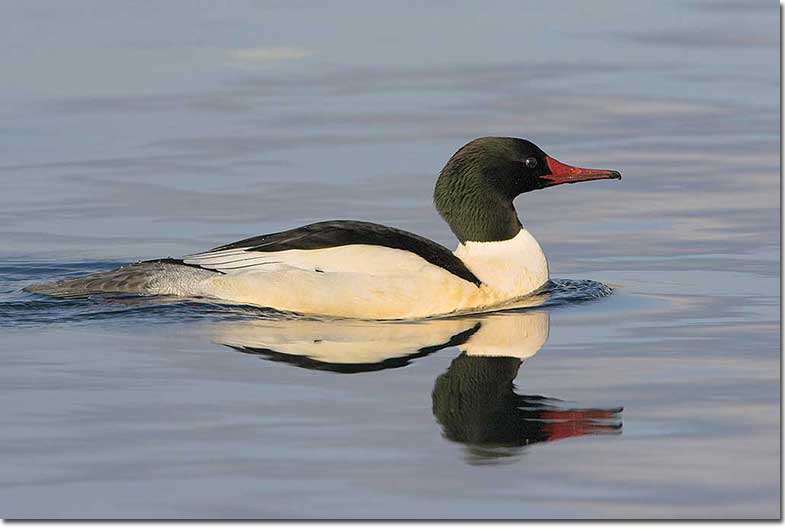
Scientific name: Mergus merganser
Length: 25 inches
Wingspan: 34 inches
Common Mergansers are big and slender ducks with pointed red beaks. Based on their size, the English name of “Goosander” for this bird seems fitting!
Breeding males are white with a dark green head and some black on their back and wings.
Female and nonbreeding male Common Mergansers are gray with a brown head, small white throat, and white on their belly. When flying, this species shows a lot of white on the base of their wings.
They have fast, direct flight and, after the breeding season, usually occur in small flocks.
These highly aquatic ducks catch fish and crustaceans after pursuing them underwater.
Key identifications:
- Red, pointed beak.
- Distinct brown head with a white throat.
- Males have all white underparts.
Wood Duck
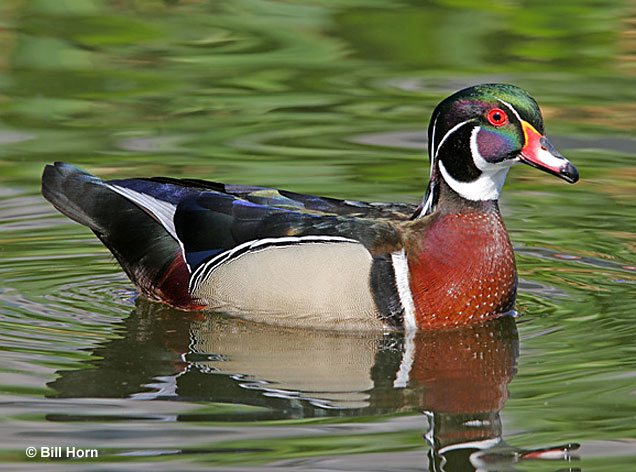
Scientific name: Aix sponsa
Length: 18.5 inches
Wingspan: 30 inches
Wood Ducks are seriously ornamental birds. The males can seem so exotic, it might be hard to believe they are a wild, native species! However, Wood Ducks are indeed native and fairly common in many parts of southern Canada and the USA.
These cute, slender, long-tailed ducks prefer wooded swamps and other wetlands in forested habitats. The males have a rounded head with a dark green crest, black and white face, short red beak, and jade green back. They also have bright buff flanks and a chestnut chest and undertail.
Female Wood Ducks grayish-brown birds that aren’t nearly as fancy but can still be recognized by their blocky head, white spectacles, slender shape, and mostly dark wings.
Wood Ducks usually occur in pairs but can also form small flocks that forage for acorns, plant matter, and small creatures in and near water. We often hear these ducks give their odd, squealing whistle vocalization before we see them.
Key identifications:
- Slender duck with a longish tail and a blocky head.
- Ornate plumage a short, reddish beak.
- Dark wings with a narrow white line on the base of the trailing edge.
Greater Scaup
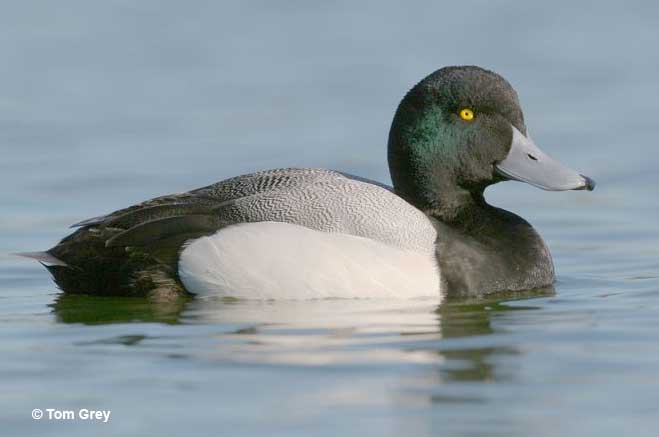
Scientific name: Aythya marila
Length: 18 inches
Wingspan: 28 inches
Greater Scaups are medium-sized ducks with pretty hefty, bluish beaks, and a rounded head with a pronounced forehead. Males have white bodies with pale gray backs, a blackish head with green iridescence, black chest, and black rump, tail, and undertail.
Female Greater Scaups are gray-brown birds that are darker brown on their heads, chest, and rear end. They also have a white patch on the front of their face. Both sexes also have pale eyes, and, in flight, show white bellies, and a broad white stripe on most of their wings.
Greater Scaups dive underwater to forage for mollusks and some other creatures.
This duck species breeds on lakes and shallow wetlands pretty far north! You are more likely to see them during winter.
Key identifications:
- Large, blue-gray beak with black tip.
- Rounded head that has a prominent projecting forehead.
- In flight, white stripe that nearly reaches the tip of the wing.
Hooded Merganser
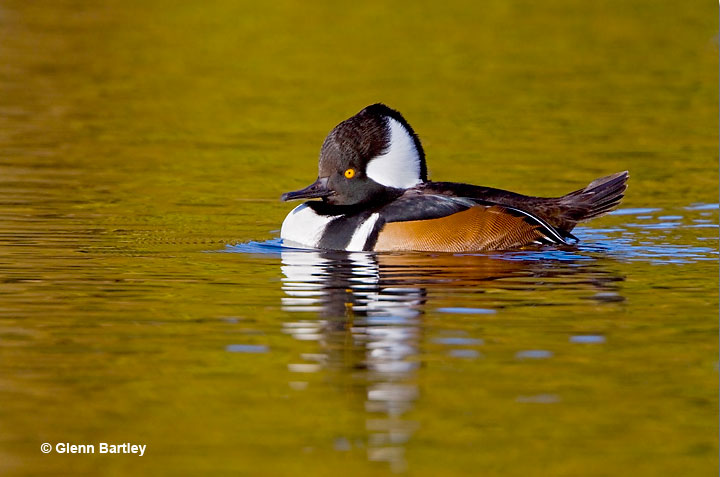
Scientific name: Lophodytes cucullatus
Length: 18 inches
Wingspan: 24 inches
The Hooded Merganser is one of the prettiest little ducks in North America. Breeding males are handsome ducks with a rounded black and white head, and black neck and back. Their jet black upperparts combine nicely with two black marks on a white chest, and rich, pumpkin-colored flanks.
Females aren’t as colorful but are still pretty in their own way. These brown-gray birds have a slender, yellowish beak, and a deep, caramel-colored, rounded crest.
Both sexes also have a longish, somewhat pointed tail, and small white markings on the base of their slender dark wings.
Hooded Mergansers dive for crayfish, small fish, and other small creatures in wooded swamps and marshes. We don’t see them flock together as much as other ducks do, and they usually occur as pairs.
They usually do not breed in California, but you can see more of them starting form October, all the way to mid-April.
Key identifications:
- Small duck with a small, slender beak.
- Blocky or rounded head.
- White belly and a bit of white on the base of narrow wings.
Canvasback
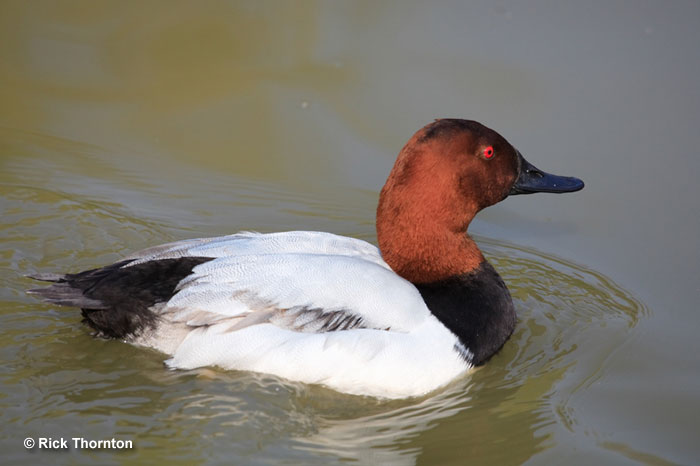
Scientific name: Aythya valisineria
Length: 21 inches
Wingspan: 29 inches
Canvasbacks are distinctive, medium-sized ducks with a long, gently sloping, black beak. No other duck in North America has a beak like the Canvasback, maybe nowhere else either!
Males have a beautiful, dark chestnut head, dark eyes, black chest, and a pale gray and white body. They also have a black rump, tail, and undertail.
Female Canvasbacks have the same shape as male birds but look quite different. They are pale gray with a sandy brown chest, neck, and head. In flight, both sexes show a lot of white on their underwings.
This duck species dives underwater to forage for mollusks and other aquatic creatures.
Canvasbacks breed in shallow marshes in Alaska, western Canada, and parts of the western USA. They usually only winter in California
Key identifications:
- Big, long, blackish, sloped beak.
- Male has black chest, pale gray body, and dark chestnut head.
- Female has brownish-gray body, and pale brown head and chest.
Frequently Asked Questions
How many duck species are there in California?
There are 37 duck species in California. However, at least 13 of those duck species are rare vagrants.
Where do California ducks go in the winter?
In the winter, California ducks go to wetlands in Mexico but many also winter in southern California.
Do ducks migrate to California?
Yes, many ducks migrate to southern California.
Do Mallards live in California?
Yes, Mallards live in California. According to eBird sightings, the Mallard is the most common duck species in the state.
More in California: Most common birds | Hawks | Owls | State Bird


Florida Jenkins
Saturday 20th of April 2024
The visuals you included really helped make this clear. Great choice!